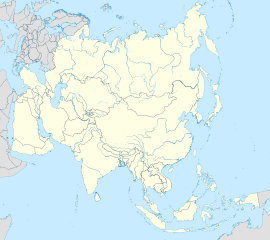
Back Chiang Mai Afrikaans تشيانغ مي Arabic Chiang Mai BAN Чыянгмай Byelorussian Чианг Май (град) Bulgarian চিয়াং মাই Bengali/Bangla ཆེང་མྰེ། Tibetan Chiang Mai Breton Chiang Mai Catalan Chiang Mai (kapital sa lalawigan sa Thayland) CEB
Chiang Mai
เชียงใหม่ ᨩ᩠ᨿᨦᩉ᩠ᨾᩲ᩵ | |
|---|---|
| Chiang Mai City Municipality เทศบาลนครเชียงใหม่ | |
From top, left to right: Aerial view of Chiang Mai, Wat Phra Singh, Tha Phae Gate, Wat Phra That Doi Suthep, and Wat Chiang Man | |
 | |
| Coordinates: 18°47′43″N 98°59′55″E / 18.79528°N 98.99861°E | |
| Country | |
| Province | |
| Amphoe | Mueang Chiang Mai |
| City municipality | 29 March 1935[1] |
| Districts | 4
|
| Government | |
| • Type | City municipality |
| • Mayor | Atsani Puranupakorn |
| Area | |
| 40.216 km2 (15.5274844 sq mi) | |
| • Urban | 405 km2 (156.371 sq mi) |
| • Rank | 11th |
| Elevation | 304 m (997 ft) |
| Population (2019)[2] | |
| 127,240 (Municipal area) | |
| • Rank | 8th |
| • Density | 3,164/km2 (8,190/sq mi) |
| • Urban (2022) | 1,198,000 (Principal city area/เขตเมือง) |
| • Urban density | 2,958/km2 (7,660/sq mi) |
| • Metro | (To be announced) |
| Time zone | UTC+07:00 (ICT) |
| Postal code | 50000 |
| Calling code | 053 & 054 |
| Airport | Chiang Mai International Airport |
| Inter-city rail | Northern Line |
| Website | cmcity.go.th |
Chiang Mai[a] is the largest city in northern Thailand, the capital of Chiang Mai province and the second largest city in Thailand. It is 700 km (435 mi) north of Bangkok in a mountainous region called the Thai highlands and has a population of 1.2 million people as of 2022, which is more than 66 percent of the total population of Chiang Mai province (1.8 million).[3][4][5]
| Chiang Mai | |
|---|---|
 | |
| Thai name | |
| Thai | เชียงใหม่ |
| RTGS | Chiang Mai |
| Northern Thai name | |
| Northern Thai | ᨩ᩠ᨿᨦᩉ᩠ᨾᩲ᩵ [t͡ɕīəŋ.màj] |
Chiang Mai (meaning "new city" in Thai) was founded in 1296 as the new capital of Lan Na, succeeding the former capital, Chiang Rai.[6]: 208–209 The city's location on the Ping River (a major tributary of the Chao Phraya River) and its proximity to major trading routes contributed to its historic importance.[7][8]
The city municipality of Chiang Mai (thesaban nakhon) officially only covers parts (40.2 km²) of the Mueang Chiang Mai district in the city centre and has a population of 127,000.[4] This census area dates back to 1983 when Chiang Mai's municipal area was enlarged for the first and last time since becoming the first City Municipality in Thailand (then under Siam) in 1935. The city's sprawl has since extended into several neighboring districts, namely Hang Dong in the south, Mae Rim in the north, Suthep in the west and San Kamphaeng in the east, forming the Chiang Mai urban area with over a million residents.
The city municipality is subdivided into four khwaeng (electoral wards): Nakhon Ping, Sriwichai, Mengrai, and Kawila. The first three are on the west bank of the Ping River, and Kawila is on the east bank. Nakhon Ping District includes the northern part of the city. Sriwichai, Mengrai, and Kawila consist of the western, southern, and eastern parts, respectively. The city center—within the city walls—is mostly within Sriwichai ward.[9]
- ^ [1],"พระราชบัญญัติจัดตั้งเทศบาลนครเชียงใหม่ พุทธศักราช ๒๔๗๘"
- ^ "สถิติทางการทะเบียน" [Registration statistics]. bora.dopa.go.th. Department of Provincial Administration (DOPA). December 2019. Retrieved 22 September 2020.
Download จำนวนประชากร ปี พ.ศ.2562 - Download population year 2019
- ^ "National Statistical Office Thailand – Population Data 2022". statbbi.nso.go.th. Retrieved 2023-07-28.
- ^ a b "Department of Provincial Administration (DOPA), Population data for the year 2022".
- ^ "Chiang Mai, Thailand Metro Area Population 1950-2022, Data provided by the United Nations' Department of Economic and Social Affairs - Population Division". www.macrotrends.net. Retrieved 2022-03-16.
- ^ Cite error: The named reference
Coedeswas invoked but never defined (see the help page). - ^ "Chiang Mai Night Bazaar in Chiang Mai Province, Thailand". Lonely Planet. 2011-10-24. Archived from the original on 2012-08-06. Retrieved 2012-07-05.
- ^ "มหาวิทยาลัยนอร์ท-เชียงใหม่ [North – Chiang Mai University]". Northcm.ac.th. Archived from the original on April 24, 2012. Retrieved 2012-07-05.
- ^ "Chiang Mai Municipality" (in Thai). Chiang Mai City. 2008. Archived from the original on September 15, 2008. Retrieved 2008-10-04.
Cite error: There are <ref group=lower-alpha> tags or {{efn}} templates on this page, but the references will not show without a {{reflist|group=lower-alpha}} template or {{notelist}} template (see the help page).








